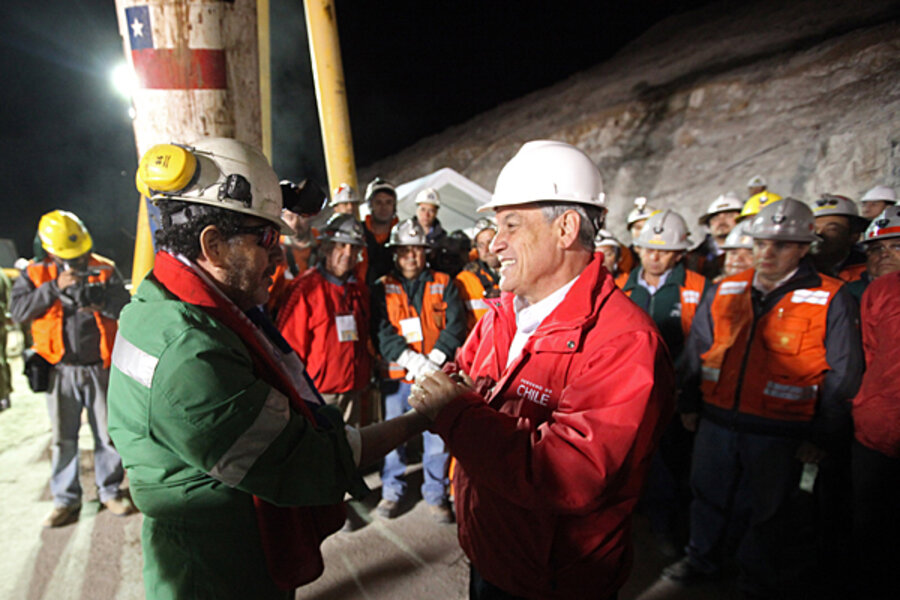Chile mine rescue: 3 years later, Piñera tries to recapture the political magic
Loading...
| San José Mine, Chile
President Sebastian Piñera returned to the shuttered San José mine to remember the spectacular rescue of 33 trapped workers that marked the high point of his presidency. On the third anniversary of the rescue, he opened a museum on the site and said the rescue changed the meaning of “the Chilean way.”
“Before, the Chilean way meant something half-baked and improvised. It transformed into doing something with faith, unity, and hope,” President Piñera told a crowd of 300 on Sunday, including 13 of the miners who spent 70 days a half-mile below the surface.
With just months left in his term, Piñera sought to recapture some of the magic of 2010, when government-backed teams saved the miners and demonstrated Chile’s toughness, dedication, and technical competence. With presidential elections just a month off, Piñera is consolidating his own legacy and that of his conservative ideals in a country that has long distrusted the political right.
Piñera is barred by the constitution from running for immediate reelection. His ideas face a challenge as the conservative presidential candidate in next month’s election, Evelyn Matthei, has so far struggled to gain traction against popular ex-president Michelle Bachelet.
Ms. Matthei is favored by 23 percent of voters, Reuters reported last week, citing a poll by Ipsos. Ms. Bachelet, who left office four years ago and is now permitted to run again, had 33 percent support. Seven more candidates divided up the rest of respondents' support, according to Ipsos.
Piñera won election thanks in part to voter fatigue with the moribund Concertación, a group of center-left parties that governed for 20 years after the fall of dictator Augusto Pinochet. A billionaire executive, academic, and senator, Piñera was the first conservative candidate to win the presidency since 1958.
Before he could take office, however, the country was shattered by an 8.8-magnitude earthquake — his swearing-in was interrupted by an aftershock. He spent his first months focused on the thankless task of recovery.
When a mine collapsed near the city of Copiapó in August 2010, public pressure from relatives of the trapped miners prompted Piñera to mount a rescue effort. The 70-day rescue attracted worldwide attention and made Piñera a star, with his approval rating rising to 63 percent, from 46 percent three months earlier, according to pollster Adimark GfK.
Piñera traveled the world showing off rescue souvenirs but the glow soon dimmed. Within a year, Piñera’s approval fell to 27 percent as he was blamed for the firing of the popular coach of the national soccer team and students marched in the country’s biggest wave of demonstrations since the Pinochet era, demanding better-funded, higher-quality education.
Sunday's visit was the third time he marked the anniversary here in the Atacama desert, 500 miles north of the capital, Santiago.
“Pinera did take a great political risk with the miners, as it could have gone horribly wrong, and it paid off,” says Robert Funk, director of the Center for the Study of Public Opinion at the University of Chile. “That’s his entrepreneurial style.”
Asked if Chileans still care about the mine rescue, Mr. Funk said: “No.”
Piñera has since recovered some support, but hasn’t since exceeded 40 percent approval, according to Santiago-based Adimark.
Piñera has never attracted much support from the left-wing Concertación coalition, and has alienated some members of his own conservative coalition, known as the Alianza. Like the US Republican Party, Funk says the Alianza is now divided between hard-liners and moderates, with Piñera taking heat from more right-wing conservatives.
Mine safety
Beyond his political ups and downs, Piñera’s policies have gotten less attention. Before the 33 miners were even brought to the surface, he pledged to increase attention to reducing workplace injuries.
The effort was worthwhile, Mining Minister Hernán de Solminihac said Saturday in an interview with The Christian Science Monitor. The government boosted the number of mine inspectors from 17 to 65, trained 6,000 workers in mine safety, and brought oversight to 1,600 unregulated mines, Mr. de Solminihac says.
“Last year was the year with the fewest fatal accidents in all our country’s history,” Piñera said at the mine Sunday. Industrial accidents declined in many industries in 2012 compared to 2011, Chile’s social security supervisor says.
Regardless of the success, neither former labor minister and presidential candidate Matthei nor front-runner Bachelet have made workplace safety a campaign issue.
One outcome of the 2010 rescue was that the mining minister at the time, Laurence Golborne, became the most popular member of the cabinet and was boosted to the ranks of possible presidential candidates. He was widely credited for spending hours with worried family members. After he started to campaign for president, the company he used to run, Cencosud, was convicted of abusive credit practices and fined $70 million. Mr. Golborne himself was accused of failing to disclose wealth he had stashed in offshore accounts and he dropped out of the race . But when he showed up at the museum inauguration on Sunday, he received hearty applause.
There have also been ongoing personal dramas. Jorge Galleguillos, who was among the mine survivors, said he has been unemployed since the accident. Ricardo Benítez, head of the foundation that represents the 33 miners, said that many of the men continue to face psychological repercussions.
While the government’s efforts to prevent accidents have been widely praised, the allocation of blame has been criticized. The owners of the San José mine were released from any criminal responsibility in August, and they have yet to be held liable in civil cases.
Pablo Rojas, who returned to work as a miner despite the 2010 ordeal, says the government has done a lot and cut the number of accidents, but he’s not taking any chances.
“I knew this mine was unsafe but I worked here because they paid a bit more,” he said. "Where I’m working now is a safer mine"







